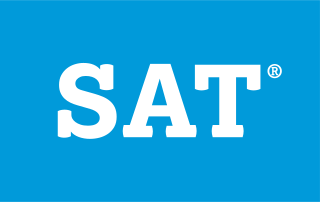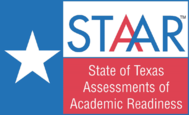
The SAT is a standardized test widely used for college admissions in the United States. Since its debut in 1926, its name and scoring have changed several times. For much of its history, it was called the Scholastic Aptitude Test and had two components, Verbal and Mathematical, each of which was scored on a range from 200 to 800. Later it was called the Scholastic Assessment Test, then the SAT I: Reasoning Test, then the SAT Reasoning Test, then simply the SAT.

A standardized test is a test that is administered and scored in a consistent, or "standard", manner. Standardized tests are designed in such a way that the questions and interpretations are consistent and are administered and scored in a predetermined, standard manner.
Educational assessment or educational evaluation is the systematic process of documenting and using empirical data on the knowledge, skill, attitudes, aptitude and beliefs to refine programs and improve student learning. Assessment data can be obtained by examining student work directly to assess the achievement of learning outcomes or it is based on data from which one can make inferences about learning. Assessment is often used interchangeably with test but is not limited to tests. Assessment can focus on the individual learner, the learning community, a course, an academic program, the institution, or the educational system as a whole. The word "assessment" came into use in an educational context after the Second World War.

The No Child Left Behind Act of 2001 (NCLB) was a U.S. Act of Congress promoted by the Presidency of George W. Bush. It reauthorized the Elementary and Secondary Education Act and included Title I provisions applying to disadvantaged students. It mandated standards-based education reform based on the premise that setting high standards and establishing measurable goals could improve individual outcomes in education. To receive federal school funding, states had to create and give assessments to all students at select grade levels.

The Texas Assessment of Knowledge and Skills (TAKS) was the fourth Texas state standardized test previously used in grade 3-8 and grade 9-11 to assess students' attainment of reading, writing, math, science, and social studies skills required under Texas education standards. It is developed and scored by Pearson Educational Measurement with close supervision by the Texas Education Agency. Though created before the No Child Left Behind Act was passed, it complied with the law. It replaced the previous test, called the Texas Assessment of Academic Skills (TAAS), in 2002.
The Education Quality and Accountability Office (EQAO) is a Crown agency of the Government of Ontario in Canada. It was legislated into creation in 1996 in response to recommendations made by the Royal Commission on Learning in February 1995.
The Standards of Learning (SOL) is a public school standardized testing program in the Commonwealth of Virginia. It sets forth learning and achievement expectations for core subjects for grades K-12 in Virginia's Public Schools. The standards represent what many teachers, school administrators, parents, and business and community leaders believe schools should teach and students should learn. The Virginia Department of Education, schools, and school systems routinely receive essential feedback on the effectiveness of implementation and address effective instructional strategies and best practices. The Standards of Learning is supportive of the No Child Left Behind Act, which was signed into law by then-President George W. Bush on January 8, 2002. They address student achievement in four critical areas: (1) English, (2) mathematics, (3) science, and (4) history/social studies. Students are assessed in English and mathematics in grades 3-8 and upon completion of certain high school level courses. Science and history SOL are administered in grades 4, 5, and 8 and at the end of completing high school courses in these respective subjects.
The California Assessment of Student Performance and Progress (CAASPP), known until February 2014 as the Measurement of Academic Performance and Progress (MAPP), measures the performance of students undergoing primary and secondary education in California. In October 2013, it replaced the Standardized Testing and Reporting (STAR) Program.
Accelerated Reader (AR) is an educational program created by Renaissance Learning. It is designed to monitor and manage students' independent reading practice and comprehension in both English and Spanish. The program assesses students' performance through quizzes and tests based on the books they have read. As the students read and take quizzes, they are awarded points. AR monitors students' progress and establishes personalised reading goals according to their reading levels.
In an educational setting, standards-based assessment is assessment that relies on the evaluation of student understanding with respect to agreed-upon standards, also known as "outcomes". The standards set the criteria for the successful demonstration of the understanding of a concept or skill.
The National Center for Fair & Open Testing, also known as FairTest, is an American educational policy organization that opposes standardized testing and their use in university admission.
The Tennessee Comprehensive Assessment Program (TCAP) is the standardized testing program used in public schools in Tennessee. Tennessee schools administer a comprehensive exam to their students at the end of each school year beginning in the third grade. Tests are intended to reflect what each child learned in the past year of school. The tested areas include reading, language arts, mathematics, science, and social studies. The TCAP currently includes the Achievement Test, the Writing Test, the Competency Test, the Gateway Tests, and the End of Course Tests. The scores are returned at the beginning of the next school year and these scores help schools make instructional decisions. Special education and limited-English proficiency students are included in the testing and may be accommodated with modifications.
The Lexile Framework for Reading is an educational tool that uses a measure called a Lexile to match readers with books, articles and other leveled reading resources. Readers and books are assigned a score on the Lexile scale, in which lower scores reflect easier readability for books and lower reading ability for readers. The Lexile framework uses quantitative methods, based on individual words and sentence lengths, rather than qualitative analysis of content, to produce scores. Accordingly, the scores for texts do not reflect factors such as multiple levels of meaning or maturity of themes. Hence, the United States Common Core State Standards recommends the use of alternative, qualitative methods for selecting books for students at grade 6 and over. In the US, Lexile measures are reported from reading programs and assessments annually. Thus, about half of U.S. students in grades 3rd through 12th receive a Lexile measure each year. In addition to being used in schools in all 50 states, Lexile measures are also used outside of the United States.
Value-added modeling is a method of teacher evaluation that measures the teacher's contribution in a given year by comparing the current test scores of their students to the scores of those same students in previous school years, as well as to the scores of other students in the same grade. In this manner, value-added modeling seeks to isolate the contribution, or value added, that each teacher provides in a given year, which can be compared to the performance measures of other teachers. VAMs are considered to be fairer than simply comparing student achievement scores or gain scores without considering potentially confounding context variables like past performance or income. It is also possible to use this approach to estimate the value added by the school principal or the school as a whole.
The Partnership for Assessment of Readiness for College and Careers (PARCC) is a consortium featuring two states, the District of Columbia, the Department of Defense Educational Activity, and the Bureau of Indian Education, that work to create and deploy a standard set of K–12 assessments in Mathematics and English, based on the Common Core State Standards.

The State of Texas Assessments of Academic Readiness, commonly referred to as its acronym STAAR, is a series of standardized tests used in Texas public primary and secondary schools to assess a student's achievements and knowledge learned in the grade level. It tests curriculum taught from the Texas Essential Knowledge and Skills, which in turn is taught by public schools. The test used to be developed by Pearson Education every school year, although the most recent contract gave Educational Testing Service a role in creating some of the tests, under the close supervision of the Texas Education Agency.
The Peabody Individual Achievement Test is a criterion based survey of an individual’s scholastic attainment. It can be administered to individuals between the ages of five and 22 years of age, and returns a grade range between Kindergarten and grade 12. The test is available in English and Spanish.

SAT Subject Tests were a set of multiple-choice standardized tests given by The College Board on individual topics, typically taken to improve a student's credentials for college admissions in the United States. For most of their existence, from their introduction in 1937 until 1994, the SAT Subject Tests were known as Achievement Tests, and until January 2005, they were known as SAT II: Subject Tests. They are still commonly known by these names. Unlike the Scholastic Aptitude Test (SAT) that the College Board offers, which are intended to measure general aptitude for academic studies, the Achievement Tests are intended to measure the level of knowledge and understanding in a variety of specific subjects. Like the SAT, the scores for an Achievement Test range from 200 (lowest) to 800 (highest).
ACT, Inc. is an American 501(c)(3) nonprofit organization, primarily known for the ACT, a standardized test designed to assess high school students' academic achievement and college readiness. For the U.S. high school graduating class of 2019, 52 percent of graduates had taken the ACT test; the more than 1.78 million students included virtually all high school graduates in 17 states.





